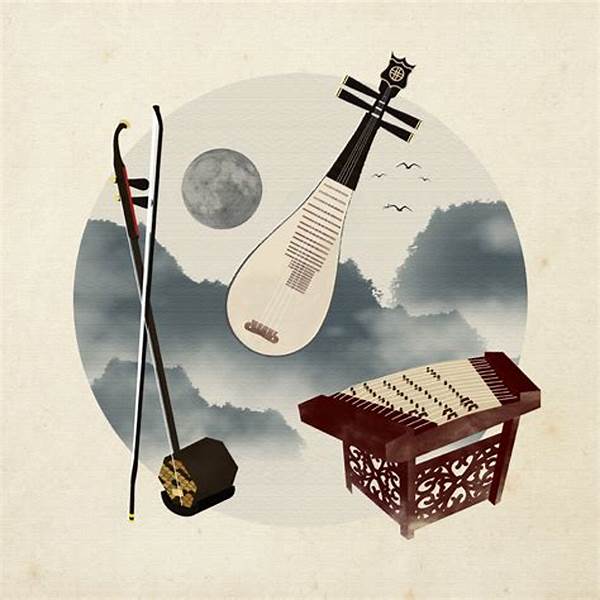In the heart of ancient China, where the teachings of Confucius held sway over the realms of philosophy and ethics, there existed a harmonious cacophony of sounds—sounds that were not merely music to entertain, but a sacred echo of divine order and social harmony. Confucian rituals, steeped in tradition and cultural reverence, used an array of traditional Chinese musical instruments to convey profound symbolism and evoke spiritual connections. These sounds were the lifeblood of ceremonies, binding the mortal to the divine and the age-old traditions to the present.
Read More : Organ Musical Instrument Inspiring Architects To Design Acoustics
Imagine attending a majestic ritual where the gentle yet profound strokes of a guqin—a seven-string zither—send ripples through the soul, inviting a meditative calmness and serenity. Meanwhile, the solemn yet magnificent call of the bianzhong—a collection of bronze bells—resonates through the air, each strike thoughtfully orchestrated to embody precise philosophical concepts. The world of these instruments is a gateway to understanding the complexities and beauties of Confucianism in ancient China. Now, let’s delve into the enchanting world of Chinese traditional music instruments used in ancient Confucian rituals.
The Importance of Music in Confucian Rituals
Music in Confucianism wasn’t just an artistic expression; it was a vital element of ritual practice, considered central to cultivating moral character, restoring justice, and harmonizing the universe. Confucian thought held that music and ritual had the power to transform society and the individual. In this context, the integration of music into rituals served multiple purposes—not only was it intended to please ancestral spirits and deities, but it also functioned as a mechanism for moral cultivation and reinforcing social hierarchies.
At the forefront of these musical expressions were the ancient melodies that profoundly impacted the psyche of both participants and spectators. The concept wasn’t to merely entertain but to educate and instill Confucian virtues such as respect, filial piety, and righteousness. This point emphasizes why the choice of musical instruments for these sacred rituals was meticulous and significant—they had to reflect the Confucian ideals that were preached and practiced through generations.
Key Instruments Used in Confucian Rituals
The Guqin: Sound of Meditative Tranquility
Among the most revered of the Chinese traditional music instruments used in ancient Confucian rituals is the guqin. This simple yet profound instrument embodies tranquility and introspection—both key tenets of Confucian thought. Played by scholars and sages, the guqin’s music was believed to purify the heart and calm the mind. Its ethereal sound, plucked by gentle hands, was meant to align the human spirit with the cosmic order, acting as a bridge between heaven and earth.
The Bianzhong and Bianqing: The Resonance of Order
Complementing the guqin was the bianzhong, an ancient Chinese musical instrument comprised of a set of bronze bells, each producing a different pitch when struck. These bells were used in a variety of rituals and were invaluable for their capability to produce harmonic and resonant tones. The bianqing, a type of stone chime, accompanied the bianzhong, creating a harmony emblematic of order and discipline, which were central to Confucian philosophy.
Understanding the Cultural Context of the Instruments
Diving deeper into the cultural context of these instruments, it’s essential to understand their roles beyond the auditory experience. In the Confucian ceremonial scope, these instruments symbolized more than sound. They represented the structured universe and humanity’s place within it. Their use reflected societal structures, with specific instruments designated for particular classes and ceremonies, reinforcing the Confucian ideals of social harmony and duty.
Symbolism and Craftsmanship
Each instrument invoked a world of symbolism. For instance, the bianzhong’s relation to metal and heaven in the Five Elements theory exemplifies how music was interwoven with broader philosophical beliefs. The craftsmanship of these instruments also deserves mention—each one was carefully fashioned by artisans, designed to withstand the test of time while providing a medium through which transitory humanity could connect with the eternal.
Read More : How Government Securities Work
Testimonies of Ancient Harmonies
Historical records and archaeological findings have unearthed testimonies to the enduring legacy of these instruments. Ancient texts, such as the ‘Book of Rites’, describe the intricate use of music in ritual contexts, while tomb excavations have revealed well-preserved instruments, offering tangible connections to ancient practices. These discoveries continue to inform and inspire present-day appreciation and revival of Confucian musical traditions.
Making the Instruments Relevant Today
While these instruments were traditionally used in ancient rituals, their presence today offers a unique opportunity to connect with history and heritage. Modern musicians and cultural enthusiasts continue to explore and celebrate these instruments, fostering a deeper understanding and appreciation of their historical significance.
In a world driven by change and technology, the slow, deliberate sound of the guqin or the resounding clarity of the bianzhong invites us to pause and reflect. It’s a reminder of the timeless wisdom encapsulated in Confucian teachings—an invitation to reconnect with the art, philosophy, and spirituality that these ancient sounds embody.
Bridging the Past and Present
By embracing these ancient instruments, we bridge the past with the present, continuing a long line of cultural tradition that respects and honors the wisdom of our ancestors. Many educational initiatives and cultural organizations worldwide have made it their mission to preserve these sounds, offering workshops and performances that breathe new life into these age-old harmonies. Through these endeavors, both young and old can experience the spiritual and cultural richness these instruments offer.
In conclusion, the Chinese traditional music instruments used in ancient Confucian rituals are not just relics of the past; they are vibrant symbols of cultural continuity and philosophical depth. By understanding and appreciating their roles in history, we gain insight into a world where music was more than sound—where it was a vessel of profound spiritual and moral meaning.
